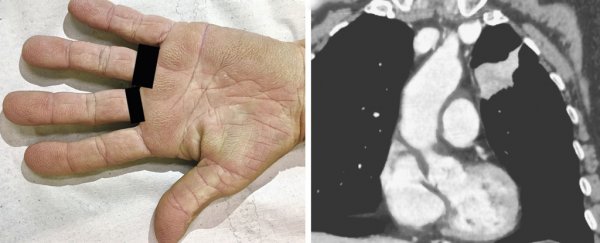When a 73-year-old patient visited a dermatology clinic about painful lesions on her hands, it was just one of many signals that all was not right with this woman's poor health.
She'd had a cough for about a year, and had lost 5 kilograms (11 lbs) in the last four months alone. Grim symptoms for anybody, but especially for an elderly smoker who acknowledged she'd gone through a pack of cigarettes every day for 30 years.
Yet it wasn't those warning signs that had brought her to the clinic, but rather the strange marks on her hands, and the pain and itching she felt from them.
"Physical examination revealed sharp demarcation of the folds in the lines of her hands in addition to a velvety appearance of palmar surfaces and ridging of the skin," her doctors write in a case report.
 (Miyashiro and Sanches, NEJM, 2019)
(Miyashiro and Sanches, NEJM, 2019)
Velvety palms like this constitute a rare medical condition known as 'tripe palms', due to their resemblance to the rippled appearance of the stomach lining of cows, pigs, or sheep.
Sometimes called acanthosis palmaris, such tripe palms fall under skin disorder categories where the skin abnormally darkens due to hyperpigmentation (as in acanthosis nigricans) or abnormally thickens (as in palmoplantar keratoderma).
The velvety surfaces that result aren't always itchy or painful. Although the exact cause of the skin changes is unknown, the distinct ridges are usually associated with an internal malignancy of some kind, with over 90 percent of cases also involving a cancer diagnosis, per one study.
Most often, tripe palm – which can occur alongside other skin abnormalities – coincides with lung cancer or gastric cancer. In the case of this 73-year-old patient, a woman from São Paulo, Brazil, a CT scan revealed irregularities in her lungs.
A subsequent biopsy confirmed a diagnosis of adenocarcinoma, and she underwent chemotherapy and radiation therapy.
There's no known remedy for tripe palms, but as the patient's doctors explain, curing the ailment that causes their appearance in the first place may have the potential to make the skin symptom disappear, although not always.
"Tripe palm lesions may resolve with treatment of the underlying cancer," the physicians note, "however, the lesions in this patient did not regress with chemotherapy or with the application of 10 percent urea-containing ointment."
More significantly, six months after the patient first presented at the skin clinic, the doctors observed her cancer had progressed, and at the time of writing their case report, the woman was beginning a second round of chemotherapy.
It's not known if that second round was successful or not, but the patient's experience goes to show just how serious this rare skin disorder can be, and how seriously we need to take it when it shows up.
"Importantly, in over 40 percent of patients, tripe palms were the presenting feature of a previously undiagnosed malignancy," scientists observed in a 1989 study.
"Therefore, all patients with tripe palms should be evaluated with a full diagnostic work-up for an associated malignancy, particularly lung or gastric carcinoma."
The findings are reported in The New England Journal of Medicine.
